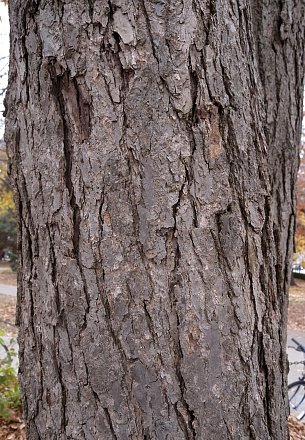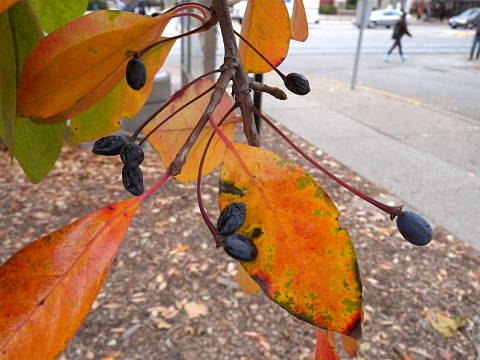
Black Tupelo is polygamo-dioecious, producing male and either female or perfect flowers on separate trees. Male flowers are produced in small umbels on slender peduncles about ½-1" long. Individual male flowers are about 1/8" (3 mm.) across, consisting of a shallow green calyx with barely discernible teeth, insignificant green petals, and 5-10 spreading stamens with long filaments. Sessile clusters of 2-5 female flowers are produced on slender peduncles about ¾-2½" long. Individual female or perfect flowers are about 1/8" (3 mm.) across, consisting of a tubular green calyx with 5 tiny teeth along its upper rim, insignificant green petals, an ovary with a single style, and 0-10 erect stamens on short filaments; these stamens are often abortive. The blooming period occurs during late spring as the leaves develop. Female and perfect flowers are replaced by individual or sessile clusters of 2-3 drupes on long slender peduncles. Individual drupes are up to ½" long and ovoid in shape, becoming blue-black at maturity. Each drupe has thin bitter-sour flesh and a single hard seed (stone) that is light tan, up to 1/3" (8 mm.) long, and ellipsoid-oblongoid in shape with 10-12 faint longitudinal grooves. The deciduous leaves are quite colorful during the autumn, becoming
Cultivation: The preference is full sun to light shade, moist to mesic conditions, and soil consisting of loam, silt-loam, or clay-loam. The growth rate and longevity of this tree are moderate. With the except of heart rot occurring in older branches and adjacent areas of the trunk, it has relatively few problems with insects or disease. Flooded conditions are tolerated only if they persist for a short period of time.
Range & Habitat: The native Black Tupelo is occasional in southern Illinois and uncommon along the easternmost tier of counties within the state. Illinois lies along the northwestern range limit of this species. Habitats are variable, consisting of rocky upland woodlands, wooded slopes, upland sand flats, floodplain woodlands, higher ground and edges of swamps, and edges of shaded seeps and springs. Trees on dry upland areas tend to be smaller in size than those growing on moist fertile ground. Black Tupelo benefits from disturbance that reduces competition from taller canopy trees. While individual trees are frequently top-killed by fire, new seedlings develop in response to greater light levels.
Faunal Associations: Information about insect pollinators is scant, although honeybees and undoubtedly other bees are attracted to the nectar of the flowers. Other insects feed destructively on the leaves, sap, wood, and other parts of Black Tupelo. This includes larvae of a gall fly (Cartodiplosis nyssaecola), plant bugs (Lepidopsallus nyssae, Lygocoris nyssae), an aphid (Aphis coreopsidis), phylloxerids (Phylloxera nyssae, Phylloxerina nyssae), armored scales (Chionaspis nyssae, Diaspidiotus forbesi, Melanaspis tenebricosa), a mealybug (Dysmicoccus difficilis), larvae of a sawfly (Caliroa nyssae), larvae of long-horned beetles (Aegomorphus morrisi, Charisalia americana), and a non-insectoid gall mite (Aceria nyssae). Larvae of several moths also feed on this tree (usually the leaves), including the Alien Probole (Probole alienaria), Tupelo Leafminer Moth (Antispila nyssaefoliella), an unnamed Nepticulid moth (Nepticula nyssaefoliella), False Underwing (Allotria elonympha), The Hebrew (Polygrammate hebraeicum), and Azalea Sphinx (Darapsa pholus). Among vertebrate animals, a large variety of birds have been observed to feed on the fruits of this tree, including the Ruffed Grouse, Cedar Waxwing, Northern Mockingbird, European Starling, Grey-cheeked Thrush, Wood Thrush, American Robin, and Red-eyed Vireo. The Bird Table provides a more complete list of these bird species. Some mammals that feed on the fruits include the American Black Bear, Eastern Gray Squirrel, and Fox Squirrel, while White-tailed Deer feed on the twigs during winter (Martin et al., 1951/1961). A turtle, the Slider (Trachemys scripta), has been recorded as feeding on either the fallen leaves or fallen fruits (Ernst et al., 1994).

Several species of bats use Black Tupelo for roost sites, especially in the southern states. This include Rafinesque's Big-eared Bat (Corynorhinus rafinesquii), Silver-haired Bat (Lasionycteris noctivagans), Southeastern Myotis (Myotis austroriparius), Evening Bat (Nycticeius humeralis), and Tricolored Bat (Perimyotis subflavus); see Martin et al. (2011), Lucas (2009), Lance et al. (2001), Perry et al. (2010), Clement (2011), Perry & Thill (2008), and Veilleux et al. (2003) for more information.
Photographic Location: The campus of the University of Illinois in Urbana, Illinois.

Comments: Black Tupelo is showiest during the autumn when its leaves assume brilliant colors and some of its fruit is still hanging on the tree. Other common names of this tree are Black Gum and Sour Gum. A variety of Black Tupelo, Nyssa sylvatica biflora (Swamp Tupelo), is very similar to the typical variety that is described here. Swamp Tupelo differs by having smaller leaves (less than 2½" long) that are more oblong in shape. The seeds of its fruits are more deeply grooved than those of Black Tupelo. Swamp Tupelo is sometimes treated as a distinct species, Nyssa biflora. It is often found in swamps and its distribution is more southern. In Illinois, Swamp Tupelo is restricted to the southern tip of the state, where it is rare. Another species, Nyssa aquatica (Water Tupelo), prefers swamps with standing water and areas along major rivers that are frequently flooded. It is a tall tree (up to 100') with a long straight trunk that is swollen at the base; Water Tupelo is a frequent associate of Bald Cypress (Taxodium distichum). This tree is also restricted to southern Illinois. It differs from Black Tupelo by having larger fruits (up to 1" long) that are borne individually, rather than in sessile clusters. It also has longer petioles. Sometimes, trees in this genus are assigned to the Dogwood family (Cornaceae).